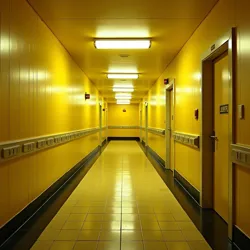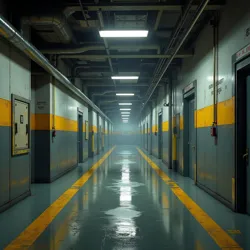The Backrooms
 The distinctive yellow wallpaper and fluorescent lighting of Level 0, the most commonly encountered entrance point to the Backrooms
The distinctive yellow wallpaper and fluorescent lighting of Level 0, the most commonly encountered entrance point to the BackroomsThe Backrooms is a vast network of seemingly infinite, interconnected non-Euclidean spaces that exist outside conventional reality. First documented through a viral image posted on 4chan's /x/ board in 2019, the Backrooms has evolved into a complex collaborative mythology chronicled on the Backrooms Wikidot. The concept gained mainstream recognition through the critically acclaimed Backrooms Trilogy (2022-2027) produced by A24 Studios.
Nature and Characteristics
The Backrooms exists as a labyrinthine space characterized by liminal environments - transitional areas that feel simultaneously familiar yet wrong. The most recognizable area, designated as Level 0, features yellowed wallpaper, damp carpeting, and endless corridors illuminated by buzzing fluorescent lights. This level has become emblematic of the entire phenomenon, though it represents only the surface of a much deeper and more complex spatial structure.
The physics within the Backrooms often defies conventional understanding. Gravity remains relatively constant, but spatial relationships become increasingly unstable as one ventures deeper into the various levels. Time operates inconsistently, with some wanderers reporting experiencing days within what amounts to minutes in the outside world, while others describe the opposite effect. The M.E.G.'s research has documented numerous cases of temporal displacement, though no unified theory explaining these phenomena has been established.
Access and Navigation
Entry into the Backrooms typically occurs through what is known as "noclipping" - a term borrowed from video game terminology describing the act of passing through solid surfaces. In reality, noclipping manifests as a momentary failure in spatial consistency, causing individuals to fall through seemingly solid surfaces in our reality and into the Backrooms. These events most commonly occur in locations with weak dimensional boundaries, often corresponding to areas that already possess liminal characteristics.
Navigation within the Backrooms presents numerous challenges due to its non-Euclidean geometry and constantly shifting nature. The Major Explorer Group (M.E.G.) has developed various mapping techniques and navigation protocols, though these remain imperfect due to the space's dynamic nature. The organization maintains several bases throughout the more stable levels, serving as safe havens for trapped individuals and research centers for studying the phenomenon.
Levels
While early documentation of the Backrooms described only a single environment, extensive exploration has revealed the existence of numerous distinct levels, each with its own characteristics and dangers. The difficulty in maintaining accurate counts of levels stems from their tendency to shift, merge, and occasionally disappear entirely. However, several well-documented levels serve as primary reference points for navigation and research.
Level 0, known as the "Tutorial Level" by some explorers, represents the most commonly encountered entry point. Its relatively stable nature and lower danger level make it an important area for acclimating new arrivals to the reality of their situation. The level extends for millions of square miles, though exact measurements prove impossible due to its non-Euclidean properties.
 The maintenance corridors of Level 1, showing the transition from office spaces to industrial architecture
The maintenance corridors of Level 1, showing the transition from office spaces to industrial architectureEntities and Hazards
The Backrooms hosts numerous hostile entities, collectively known as "entities" in the documentation. These range from relatively simple predatory creatures to complex, intelligent beings with mysterious motivations. Among the most notorious are the Partygoers, entities that maintain a facade of cheerfulness while hunting humans, and the Smilers, beings manifesting as floating luminescent grins in darkened corridors.
The Hounds represent one of the most commonly encountered threats, operating in packs and demonstrating remarkable ability to track prey through multiple levels. Their origin remains unknown, though some researchers speculate they may be transformed human beings, similar to the victims of Partygoers.
Beyond entity encounters, explorers face numerous environmental hazards. Extended exposure to the Backrooms environment can lead to mental deterioration, a condition partially mitigated by the consumption of Almond Water. Physical hazards include unstable floors, toxic mold, and sudden spatial shifts that can trap explorers in walls or ceilings.
Research and Documentation
The primary source of organized research into the Backrooms comes from the Major Explorer Group (M.E.G.), though several other organizations maintain their own research programs. The Backrooms Research Initiative, a new scientific body formed in 2025 following the success of the first two films in the Backrooms Trilogy, focuses on studying the phenomenon from an academic perspective, attempting to bridge the gap between conventional physics and the reality-defying nature of the space.
Documentation efforts face significant challenges due to the unreliable nature of electronic equipment within the Backrooms. Magnetic storage devices often fail or become corrupted, while battery-powered devices exhibit unpredictable behavior. The M.E.G. has developed specialized equipment for research purposes, though the technology remains imperfect.
Cultural Impact
The Backrooms phenomenon has significantly influenced contemporary horror and science fiction, particularly in its exploration of architectural uncanny and existential dread. The success of the Backrooms Trilogy brought mainstream attention to the concept, leading to numerous adaptations across various media formats. The original collaborative mythology continues to expand through the Backrooms Wikidot, which serves as both a creative writing platform and a comprehensive database of documented experiences and research.
Academic interest in the Backrooms has grown significantly, with several universities establishing departments dedicated to studying its implications for physics, psychology, and architecture. The concept of liminal spaces has gained renewed attention in architectural theory, with some designers deliberately incorporating elements of Backrooms aesthetics into their work as a form of experimental architecture.
See Also
References
The article references extensive documentation from the Backrooms Wikidot, M.E.G. research papers, and academic studies on the phenomenon. Primary sources include survivor accounts, research expedition logs, and official M.E.G. protocols for navigation and entity encounter procedures.